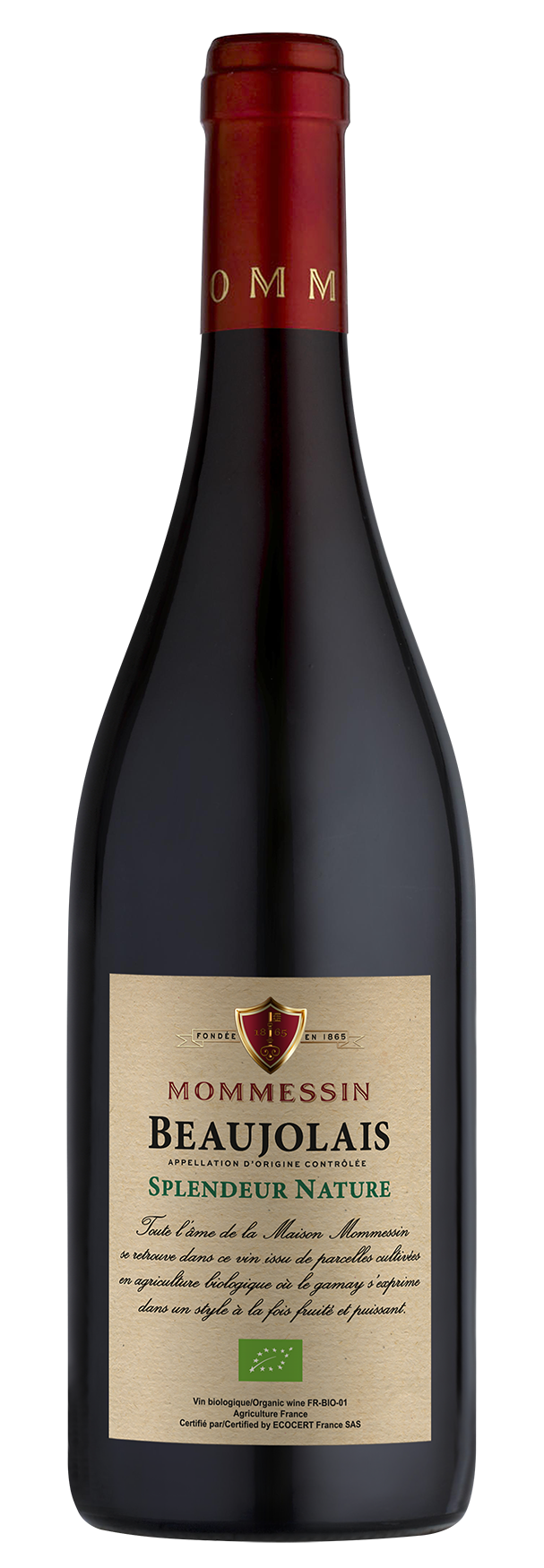BEAUJOLAIS BIO 2022
Grape varietal
100% Gamay.
Tasting notes
Colour: Beautiful, intense ruby colour.
Nose: The bouquet is equally intense, offering subtle, varied aromas of red fruit.
Palate: A fine, elegant wine that reveals a wide range of crisp fruit flavours and tremendous freshness.
Serving suggestions
Serve at a temperature of 13-14°C. (55-57°F).
Food and wine pairing
May be enjoyed simply as an aperitif, accompanied by a selection of local charcuterie or a home-made country terrine, or during a meal, accompanied by white meat, grilled food, vegetarian cuisine, savoury tarts, pasta dishes or a lightly seasoned pizza. It also goes very well with mature cheeses.
Ageing potential
Already very pleasant, this Beaujolais can easily be cellared for up to five years.
Origins
The Beaujolais appellation essentially groups together wines from the region located south of Villefranche-sur-Saône. The vineyards vary enormously, extending over 9,700 hectares overlooking the Saône plain between Mâcon and Lyon and bordered to the west by the foothills of the Massif Central.
Terroir
Our wine is made from organically grown Gamay grapes from three different plots.
Two of these consist of mainly hard limestone soil and marl slopes covered with scree with some rows of vines planted on residual clay with pieces of chert.
The vines on the third plot are planted mainly on granite with some on siliceous volcanic rock and on schist or bluish rock.
Vine and soil
- Planting density: 8,000-10,000 vines/ha
- Average age of the vines: 45 years old.
- Yield: 30hl/ha.
- Pruning: Cordon or Single Guyot.
- Vineyard management: organic agriculture.
Everything is carefully analysed: the threat of diseases, the numbers of insect pests and auxiliaries present in the plots’ agro-system, the size and number of bunches, the effect of weeds, the state of the vines’ foliage, etc.
Soil management: decavaillonnage (turning over the soil around the base of each vine), light ploughing, work between the vines.
This approach meets two objectives:
- restoring the physiological balance of the vines, the soil and the terroir,
- protection and respect of the environment.
Vinification and maturing
The Gamay grapes were sorted out in the vineyard and then, once again, at the arrival at the winery. Most of the grapes were destemmed and macerated for 8-10 days.
There are also wines produced in the traditional Beaujolais style in the blend, with semi-carbonic maceration from 5 to 8 days. This wine was aged on fine lees in stainless steel and concrete vats.
Vintage : 2022
Rainfall in June was highly variable from one area to another. In the south of Beaujolais, where most of the Chardonnays are concentrated, there was little rain, unlike the north, where the crus are located.
The intense heat of July and August accelerated the ripening process for the Gamay grapes. The harvest was characterised by great disparity between the plots. Some grapes did not withstand these extreme conditions and lost a lot of juice, while others resisted them exceptionally well. Several factors explain these divisions such as the heavily drained soil, the exposure, and the age and yield on the vine. There was little difference between the early and late sectors.
The harvest took place from 23 August to 10 September.
Volumes were lower throughout the appellation, but the quality was good.
This year we have focused on de-stemming with long macerations to enhance the wine's elegance. Naturally, our traditional semi-carbonated vinification with whole grapes is still used to extract the aromatic finesse of the Gamay grapes, as well as some hot pre-fermentative maceration to extract as much colour as possible from the grapes that suffered the most from the drought.
The wines are beautifully concentrated with a lovely volume in the mouth. Tannins are prominent. Tasting is a real pleasure. The nose and palate reveal raspberry and cherry liqueur aromas, smooth blueberry cream accompanied by violets, dark chocolate and pear.




